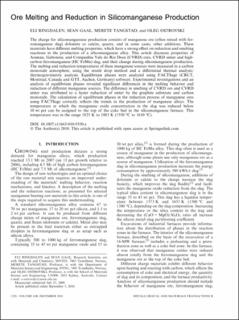| dc.contributor.author | Ringdalen, Eli | |
| dc.contributor.author | Gaal, S. | |
| dc.contributor.author | Tangstad, Merete | |
| dc.contributor.author | Ostrovski, Oleg | |
| dc.date.accessioned | 2020-12-22T11:42:22Z | |
| dc.date.available | 2020-12-22T11:42:22Z | |
| dc.date.created | 2011-01-18T10:48:56Z | |
| dc.date.issued | 2010 | |
| dc.identifier.citation | Metallurgical and materials transactions. B, process metallurgy and materials processing science. 2010, 41 (6), 1220-1229. | en_US |
| dc.identifier.issn | 1073-5615 | |
| dc.identifier.uri | https://hdl.handle.net/11250/2720765 | |
| dc.description.abstract | The charge for silicomangansese production consists of manganese ore (often mixed with ferromanganese slag) dolomite or calcite, quartz, and in some cases, other additions. These materials have different melting properties, which have a strong effect on reduction and smelting reactions in the production of a silicomanganese alloy. This article discusses properties of Assman, Gabonese, and Companhia Vale do Rio Doce (CVRD) ores, CVRD sinter and high-carbon ferromanganese (HC FeMn) slag, and their change during silicomanganese production. The melting and reduction temperatures of these manganese sources were measured in a carbon monoxide atmosphere, using the sessile drop method and a differential thermal analysis/thermogravimetric analysis. Equilibrium phases were analyzed using FACTSage (CRCT, Montreal, Canada and GTT, Aachen, Germany) software. Experimental investigations and an analysis of equilibrium phases revealed significant differences in the melting behavior and reduction of different manganese sources. The difference in smelting of CVRD ore and CVRD sinter was attributed to a faster reduction of sinter by the graphite substrate and carbon monoxide. The calculation of equilibrium phases in the reduction process of manganese ores using FACTSage correctly reflects the trends in the production of manganese alloys. The temperature at which the manganese oxide concentration in the slag was reduced below 10 wt pct can be assigned to the top of the coke bed in the silicomanganese furnace. This temperature was in the range 1823 K to 1883 K (1550 °C to 1610 °C). | en_US |
| dc.language.iso | eng | en_US |
| dc.rights | Navngivelse 4.0 Internasjonal | * |
| dc.rights.uri | http://creativecommons.org/licenses/by/4.0/deed.no | * |
| dc.title | Ore melting and reduction in silicomanganese production | en_US |
| dc.type | Peer reviewed | en_US |
| dc.type | Journal article | en_US |
| dc.description.version | publishedVersion | en_US |
| dc.rights.holder | The Author(s) 2010. This article is published with open access at Springerlink.com | en_US |
| dc.source.pagenumber | 1220-1229 | en_US |
| dc.source.volume | 41 | en_US |
| dc.source.journal | Metallurgical and materials transactions. B, process metallurgy and materials processing science | en_US |
| dc.source.issue | 6 | en_US |
| dc.identifier.doi | 10.1007/s11663-010-9350-z | |
| dc.identifier.cristin | 526241 | |
| dc.relation.project | Norges forskningsråd: 182617 | en_US |
| cristin.unitcode | 7401,80,4,2 | |
| cristin.unitcode | 7401,0,0,0 | |
| cristin.unitname | Prosessmetallurgi og råmateriale | |
| cristin.unitname | Stiftelsen SINTEF | |
| cristin.ispublished | true | |
| cristin.fulltext | original | |
| cristin.qualitycode | 2 | |

